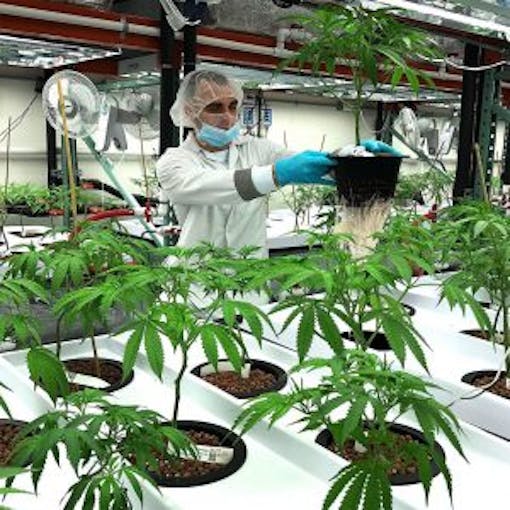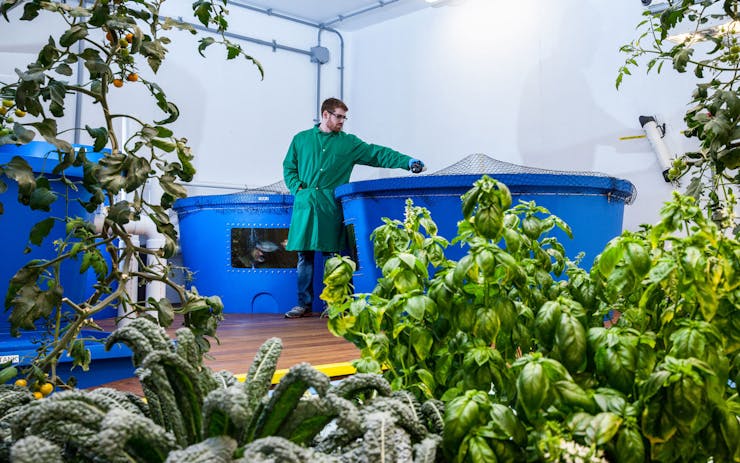Canada’s newly legal cannabis industry might still be in its infancy but the legacy of illicit growers continues to contribute to greener agricultural practices across the globe.
The once covert operations—meant to keep cannabis cultivation under police radar—can be credited with creating innovative farming techniques that curb agricultural waste and save on natural resources like space and water.
See how cannabis has already helped in making the future a little greener.
Join the Leafly Canada CommunitySustainable, environmentally-friendly farming practices may not have been the initial goal, but are among the unintended side effects of cannabis prohibition in this country.
Looking back to the 1970s when cannabis consumption was skyrocketing in Canada, supply simply could not keep up with demand and prices rose accordingly.
The problem was the supply chain. Most cannabis was brought into Canada by tourists, or people posing as them, returning from tropical nations like Jamaica, Mexico or the Bahamas. Law enforcement seized a big chunk of that illicit supply, causing numerous dry periods.
The solution to the problem was for cannabis enthusiasts to grow their own. That was easy for people living in California, but not so much for those in Nova Scotia.
Canadian cannabis consumers, however, persevered.
Growing indoors, they constantly improved their technology to include hydroponics, aeroponics, grow-lights and other devices to promote growth.

Sean Berrigan/Leafly
They selectively bred strains that were not just hardier, more bountiful, and increasingly potent, but used the same care that vintners take with fine wine to ensure traits they desired.
In just more than a generation, Canada went from having virtually no cannabis crop to becoming the No. 8 producer in the world, according to the UN, and a net exporter of what many consider among the world’s best varieties.
Shop highly rated dispensaries near you
Showing you dispensaries nearAnd now, those same technologies and practices are being brought to other agricultural products in a phenomenon called vertical farming.
Essentially, the legacy concepts pioneered by cannabis growers have been adopted by people and companies growing other produce indoors with outstanding results. Although most of the biggest producers are in Japan, Taiwan and large American cities—where they can take up whole high-rises and warehouses—it’s quickly becoming big business in Canada too.
According to the Food and Agriculture Organization of the United Nations, as much as 20% of the world’s food supply is grown in urban situations. And Allied Market Research predicted in a White Paper that vertical farming will take in nearly six times as much revenue in 2023 as it did in 2016.
It makes perfect sense. More efficient land use, less water used, few if any pesticides, lower fertilizer use, year-round harvests, and availability where people live without refrigeration or trucking are all cost reducers and environment helpers. And because the process is cleaner than traditional farming, yields are huge and even taste can be improved.
“When you do a side-by-side test of the flavour,” said Rob Wing, executive chef for the Eataly gourmet market chain, “the taste isn’t even comparable.”
Leafly spoke with Ricky (not his real name), a veteran Abbotsford grower who started with a single plant in 1985 and 20 years later, was cultivating dozens. “People talk about it like it’s a new idea,” he said. “But we’ve been doing it since forever.”
He explained that cannabis growing was forced inside as much by law enforcement as climate; but acknowledged that by being able to control the farm’s temperature, he could harvest year-round.
Of course, such covert indoor cultivation requires artificial light. “That’s when the cops started looking at everyone’s utility bills,” he told us. Residences that used an inordinate amount of electricity were flagged as potential grow-ops. So, growers like Ricky switched to more efficient LED lights, reducing their electricity use. Business began to boom, and Ricky made cannabis cultivation his full-time job.
To keep up with demand without moving to a bigger, more conspicuous location, he had to become more efficient—and that required serious technology. “I tried hydroponics, but didn’t like all the water usage,” he said. “So, I switched to aeroponics.” That not only increased his output, but allowed him to grow far more potent cannabis.
Sensing legalization over the horizon, Ricky sold his plants and equipment and went into real estate. “I might have made a mistake, though,” he said, after reading some articles about successful urban farmers and noting how similar they are to his old operation. “I just should have switched to tomatoes or something.”
Even now that cannabis cultivation has gone big-scale and corporate, the innovations aren’t stopping. Hamilton’s Green Relief has embarked on an entirely new way to grow cannabis. Called aquaponics, the cannabis plants are grown alongside tanks of tilapia. The fish produce waste that is processed into fertilizer and the plants filter and clean the water for the tilapia.
“Hydroponic cultivators have to drain their tanks every couple of weeks and refill them, starting the process all over again,” said Allan Glanfield, Green Relief’s marketing director. “Ours is closed circuit, from plants to fish to plants again.” The yield, the company says, is ten times as high as traditional methods and requires 90% less water. He likens the process to how lily pads grow in a natural setting.
While Green Relief could turn the tilapia it raises into a revenue stream, Glanfield said that the company donates them to Second Harvest to help feed the needy in the Hamilton area.
Although Green Relief is the only large-scale aquaponics farm in North America, Glanfield said that he is aware of several others in the startup process, and not all for cannabis.
“We’ve worked out the kinks and have an effective system, so it’s no surprise to see others adopt it,” he said. “We don’t feel threatened by them, we just like being reminded that it’s a great idea.”

Gage Cannabis/Facebook
Green Relief founders Warren and Lyn Bravo are so dedicated to the cause that they are building a smaller version of their farm for their backyard to provide them with fresh vegetables and fish.
Farms are moving indoors not just because they are cleaner, more efficient, and offer better products, but also because of the profit incentive. And it’s not just cannabis.
In many vertical farms, according to a study conducted by Agrilyst, Cornell University, Urban Ag News, foodshed.io, the Association for Vertical Farming, and FarmersWeb, it was determined that similar profits can be made by growing flowers, greens, microgreens, and herbs. And you don’t have to go through an arduous, years-long process to get a license to grow flowers.
So, when your future self is enjoying a big fat salmon steak along with fine fruits and vegetables all grown a few blocks away and harvested fresh that day, raise a glass to the pioneering cannabis growers who made it all possible.





